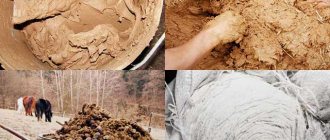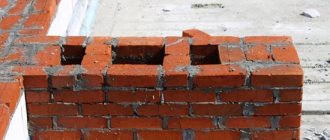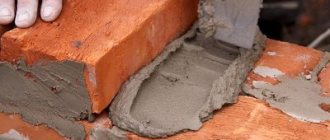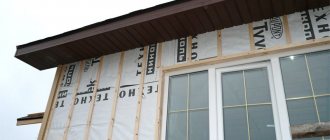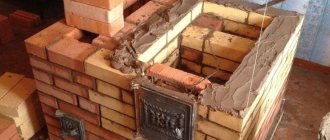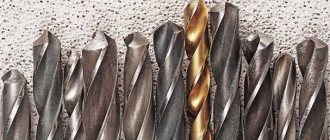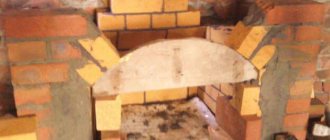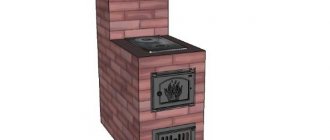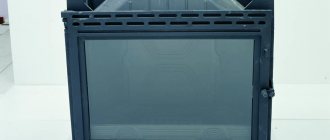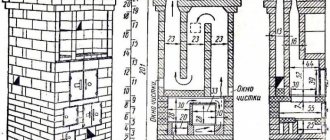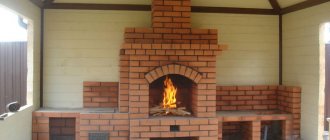When building a traditional Russian stove, fireplace or simple barbecue, no stove builder can do without bricks with fire-resistant properties. This material is indispensable when creating masonry heating equipment. It is made from fireclay powder and refractory clay. Such bricks are resistant to heating up to 1.5-1.6 thousand degrees. The material is rough to the touch. It is worth getting acquainted with its characteristics and learning how to prepare a mortar for laying bricks in a bathhouse.
Preparation of the solution
Fireclay bricks are cut with a grinder. For such work it is necessary to use a diamond-coated disk. Unlike ordinary red brick, fireclay does not need to be soaked. However, before starting to create masonry, the surface of each treated element should be cleaned of dust. The masonry joint should have a thickness of no more than 3 mm.
It is necessary to understand that red brick must be laid on red clay. Bricks that are fire resistant should only be laid on fire clay.
The mortar for masonry is prepared with your own hands. A regular dry mixture can be used. It is also called fireclay mortel. In any case, to make fire clay, you will need to use clean rainwater. It should not be oily or contain a lot of salts.
Every 100 bricks must be laid in 3 buckets of mortar. This is about 40 kg of dry mixture. That is why before purchasing products you should check the order of the stove.
Dry mixtures sold in stores are simply diluted with water. Mixing is carried out using a mixer. It is necessary to add water until the solution looks like sour cream. If there is quite a lot of solution, it is better to use a concrete mixer. Once the solution is mixed, it must be left for 1 hour. Then it is stirred again. To increase the strength of the material, it is necessary to add about 15% Portland cement to the solution.
Despite the fact that buying a ready-made mixture saves a lot of time, laying on a martel allows for good shrinkage. It is less durable when compared to clay to which fireclay sand is added. By mixing the mortar for fireclay bricks yourself, the strength of the masonry will increase significantly.
Afterwards, you need to take a pack of refractory clay and soak it for 12 hours. It is better if it is left for two days. Water should completely cover the material. The clay is stirred regularly. Then it is thoroughly rubbed through a sieve. This tool must have cells of 3x3 mm.
Particular attention is paid to the smell of the material. Usually it has no odors. If the clay has a pungent odor that causes hostility, you can understand that certain additives remain in it. After thoroughly wiping the clay, you need to add sand to the solution.
Do not place marble chips or quartz sand. It is better to choose fireclay sand. If there is no such material, you can use it. Mountain sand. It should not contain sludge or foreign impurities. First you should sift the sand - for this you use a sieve with small cells. It is better if the solution is made from two parts sand and one part refractory clay.
Working with mortar and refractory bricks
When laying, special attention must be paid to correct and high-quality jointing, since water gets into buried or unsealed seams. If the water in them freezes, it will destroy the masonry much faster than we would like. The choice of brick laying by category should depend on the planned temperature regime. The higher the planned temperature, the thinner the seam should be:
- 1 category - 1 mm;
- Category 2 - 2 mm;
- 3 category - 3 mm;
- Category 4 - wider than 3 mm.
To check the quality of the seam, a probe 15 mm wide is used, the thickness of which is equal to the thickness of the seam. The probe should penetrate 20 mm into the seam. For proper placement, each brick is tapped and leveled with the handle of a trowel. To ensure the seams have a given horizontal position and constant thickness, order slats are installed and a cord is attached to them. Starting from the first row of the layout, in the future they focus only on this cord.
The quality and strength of the masonry largely depend on how the solution is distributed (it must be spread evenly).
Dry brick will remove moisture from the mortar prematurely, preventing it from hardening. To prevent this, the brick is continuously moistened during the laying process or pre-soaked for several hours.
High quality results
Once the sand has been added, you can start pouring water into the solution. During the process it is necessary to stir the material. It is necessary to ensure that the solution does not flow from the trowel and does not stick to it. It should slide down slowly. In this case, there should be no traces left on the instrument.
High quality refractory bricks are able to maintain ductility. At the same time, it is not subject to delamination and remains quite durable. There are no lumps of clay on it. When mixing a high-quality solution, you do not need to add special products to it.
However, if it is necessary to increase the strength of the mixture, salt is added to it at a rate of 150 g per bucket. Cement 150 can be used per bucket, you need to add half a trowel. During the mixing process, you need to monitor the process - various objects should not get into the clay - glass, nails, etc.
To ensure that future masonry can be used in conditions of elevated temperatures, you should choose a solution for fireclay bricks. It is prepared in a special way. It also has fire-resistant properties. Bricks with fire-resistant properties can only be laid on a mixture made from clay and sand. Often the solution is purchased ready-made in stores. Such a solution is selected for laying a brick chimney and constructing fireboxes.
The powder has a fairly fine fraction. Until the time it is used, it is best to store it in a dry place. In order for the resulting solution to have the necessary properties, you need to mix the powder with a certain volume of water. When diluting the solution, mix it thoroughly. For this purpose, use a drill with a mixer attachment. Water is added until the mixture reaches the consistency of sour cream. We can talk about the readiness of the solution after a couple of hours of infusion.
Then it is mixed again. For strength, cement (1/6) is added to the mixture. In this case, it is necessary to calculate it in relation to the mass of the finished mixture. The solution should have a composition that is as similar as possible to the composition of fireclay bricks. It must meet the same gas and fire resistance requirements.
It is worth considering that the mortel shrinks quite quickly. For this reason, you should take ready-made ingredients and prepare the solution yourself.
Types of fireclay bricks
There are only 4 types:
- Basic.
- Carbon.
- Quartz.
- Alumina.
Production scheme.
The first 2 types are used in the manufacture of steel. The main fire-resistant building material is made on a lime-magnesium base. Carbon bricks contain quartz. It can only come into contact with fire or metal. Contact with alkali is unacceptable.
The most common is alumina (fireclay) brick. The production of refractory bricks occurs through heat treatment of a mixture consisting of fireclay powder and refractory clay.
Preparing the ingredients
For structures that will be constantly under thermal load, ordinary cement mixture is not suitable. To lay a fireplace or stove, you need to use a solution of sand and clay. To do this, you need to knead the solution with your own hands. For this you need to prepare:
- fireclay sand;
- water;
- cement powder;
- salt;
- ground clay with fire-resistant properties;
- construction sieve with small cells.
Cement may not be added to this composition. Or it may be in solution in a small volume. There should be no lumps in the solution. In order for the masonry elements to be firmly connected to each other, the solution should be made homogeneous. When dried, this mixture does not shrink much.
If fatty clay is used as a base, it can be conveniently spread over the masonry elements. The resulting product will be very thin and aesthetic. It is not recommended to use this solution when performing furnace work. This is due to the rather strong shrinkage of fatty clay.
Production and composition of refractory bricks
Refractory bricks are used in domestic and industrial construction. The composition of refractory bricks includes 70% fireclay. This is fireproof clay. It is used for the construction of buildings that will be exposed to high temperatures. It is suitable for building fireplaces, stoves, bathhouses, and barbecues with your own hands. Fireproof is a material that can operate at high temperatures without loss.
The main element of firebrick is fireclay - fireclay.
Simple building bricks are available in 2 types on the market:
Quality of clay and sand
To create a high-quality solution, you should choose very fine sand. In addition, it must be clean. The sand is sifted through a fine sieve to remove pebbles and plant debris. To understand whether the clay is suitable for work, you need to feel it. However, this method is only suitable for experienced professionals. Beginners use a different method.
To understand what quality the clay is, you need to put it in a bucket and fill it with water. Afterwards the clay is mixed. As a result, it turns out similar to sour cream. Until the clay begins to settle, a freshly planed wooden plank should be lowered into the bucket. Then it is taken out of the solution and examined. There should be some clay left on the board. If this layer is less than 1 mm, the clay is thin. It must be mixed with clays of higher fat content. When the layer turns out to be quite thick, you need to add sand. Clay with normal plasticity will adhere unevenly to the board, and the layer will be 2 mm.
A rather lengthy method for determining the quality of clay is to divide it into five portions. Each should have a volume of one liter. The first portion should be mixed with water. To the second you need to add 1/10 of a liter container of sand. In the third you need to put ¼ of the jar. The fourth portion should contain 3/4, and the last - a liter of sand.
As a result of mixing the components of the solution, it is necessary to bring it to such a state that the clay stops sticking to your hands. From all the mixtures you need to make balls and roll them into flat cakes. The drying time for clay indoors is approximately 10 days. The composition that cracks less than the others is suitable for use. The balls should not break when falling from a height of 1 m onto a hard floor.
If you don’t have time, you can put the balls on the table and press them down with a flat board. If the balls crumble immediately, it means they are made of thin clay. Oily clay manifests itself as an almost complete absence of cracks. It is better to choose the composition from which the ball is covered with small cracks by 1/3 of the size of the product.
Brick heat transfer coefficient general information
Brick heat transfer coefficient
The thermal conductivity of a brick is characterized by its ability to conduct heat energy. Such “talent” is usually displayed in a special indicator. Each species will present its own data in this regard:
- Clinker brick has a thermal conductivity in the range from 0.8 to 0.9 W/m K.
- The thermal conductivity of sand-lime brick depends on the number of voids it contains (for a slotted brick it will be equal to 0.4 W/m K), for those with technical voids the figure rises to 0.66, and for a solid version the data will already be 0.8 W/m TO.
- Ceramic bricks also have different thermal conductivity coefficients (depending on the type presented): the thermal conductivity coefficient of a solid brick gives figures from 0.5 to 0.8, slotted brick has 0.34-0.43, and porous brick has 0.22 W/m K The thermal conductivity of a ceramic brick with pores inside will be approximately 0.57 W/m K (however, even these figures may depend on the pores located in it).
As part of this analysis, it must be noted that the heat transfer coefficient of brick is not yet the highest - aerated concrete, for example, is an even better conductor. In order for the buildings being built to be truly warm, it is necessary to combine many components during construction, the main one of which will be the number of pores.
Mixing the solution
This procedure should be taken with great responsibility. This is explained by the fact that if the quantity of ingredients is incorrectly selected or the procedure is violated, it will not be possible to prepare a good solution. Clay with fire-resistant properties is soaked in water for 12-72 hours.
Then the soaked clay is rubbed through a sieve. It should have cells 3x3 mm. Dry sand must also be sifted through the same sieve. It is then added to the solution. It is best to choose a solution of the following proportions for masonry - one part clay and two parts sand. Then the ingredients are mixed to obtain a homogeneous mass. Only after this can you add water.
To obtain a good solution for fireclay bricks, it is necessary to pour water in a thin stream. The solution must be constantly stirred. You can stop pouring water only when you get a thick consistency similar to sour cream. At this stage of work, it is worth adding salt to the mixture. One bucket usually contains 150 g of salt.
This solution makes it possible to achieve higher strength of the composition. To strengthen the mixture, cement powder is added to it. Liquid glass can also be used for this purpose. The finished mixture slowly slides off the instrument. At the same time, it does not form a lump on the shovel and does not spread.
When using such a solution, all cavities of the brick are filled. The approximate volume of mortar for laying hundreds of bricks is equal to two buckets. When laying a Russian stove, this calculated amount increases by 20%. This is due to the peculiarities of the masonry of the structure.
Mortar compositions for laying various parts of the furnace
The thermal regime of each furnace element requires the use of its own solution. For example, it makes no sense to use the proportions of the composition of the fireclay lining bundle in the preparation of mortar for laying a brick chimney. Moreover, the laying of even simple stoves or fireplaces takes at least five to seven days, and the prepared solution during the day must be mixed as often as possible - interrupted and adjusted for moisture content.
Clay mortar recipes for laying fireclay bricks
In the kiln business, the composition based on clay and cement-sand compositions is considered classic. Clay, due to its high water content, makes the solution soft and plastic. The seam is approximately the same, so it must be added when laying fireclay bricks in corner joints, in places where air is supplied and combustion products are removed.
For a colder ashtray and the lower row of fireclay adjacent to the pan, the amount of clay in the solution should be the maximum of the proposed recipes. Usually, in a mixture of two parts of cement, one part of clay and two parts of fireclay powder are added with a fraction of 1 mm to 0.1 mm.
If the seam turns out to be too brittle, add a very small amount of washed white sand to the clay, about 1/5 of the amount of clay, 1/10 of fine fireclay powder and 15-20g of laundry soap.
The clay is poured with a small amount of water with dissolved soap and chopped within an hour with a bayonet, sapper shovel or similar suitable tool, adding sand and fireclay in small portions. This procedure will make the clay “lighter” and more flexible, but the solution must be used within no more than 3 hours.
Mortar for laying chamotte walls
Laying fireclay on the main walls of the firebox should be done no more than two rows per day, and it is better to leave the first row for a couple of days to level and settle the seam. To prepare the mixture, the previous method is used, but it is better to completely exclude sand from the composition. It is advisable to lay the first three rows of the firebox using a mixture with the addition of liquid glass, and increase the content of fireclay powder at least twice, this will increase the strength and rigidity of the seam, but will increase the tendency for cracks to form.
As with ceramics, the durability of the masonry and the strength of the seam depend on the quality of the clay. You cannot take very fatty and plastic clay; it has a high content of hydrated silicon and iron compounds, which has a bad effect on the further condition of the masonry, shrinkage increases and cracks appear.
Skinny types of clay are not suitable for mortar; they will not shrink, but there will be no strength either; the mortar will crumble within a couple of weeks after hardening. A reasonable balance can only be determined by practical tests with drying and heating.
Oily clay will go into solution, like soap, while thin varieties will disintegrate very poorly even under the influence of mechanical forces.
The difficulty of preparing the mixture for masonry is associated with the need to maintain the required consistency of the solution. Sodium silicate gives the mixture increased adhesion, but impairs its ductility. Most often, the viscosity of the composition is selected experimentally so that the height of the seam under the weight of the fireclay brick does not decrease by more than 10 mm.
Approximately the same composition of the solution is used for a brick chimney, but with a more viscous consistency.
Mortar for laying the firebox tray
The working conditions of fireclay bricks require increased heat resistance of the joint with minimal seam sizes and maximum adhesive strength. Most often, fireclay bricks placed in the base of the firebox are glued with a specific solution from a mixture of liquid glass - 1 part, fine powder from sawdust brick - 5 parts, fireclay clay - 2 parts.
The consistency of the solution is creamy, viscous mixtures are also good, but they will not give the minimum dimensions of the seam, and this is important. To check the quality of adhesion of the binder, the brick is moistened with water and a small portion from the batch is thrown onto the end. Accordingly, with the correct consistency and proportions, the mortar for fireclay bricks should not drain or fall off the brick surface.
Use of compositions for laying industrial fireclay
The industry produces a ready-made dry mixture for preparing a batch for fireclay bricks. This mixture is called mortar and is a mechanical mixture of the following components:
- Fireclay dry dust, as a rule, is obtained by firing refractory materials at factories; it is more active in adhesion than powder from grinding substandard fireclay bricks;
- Dry ground white bentonite clay, with a high content, up to 25%, of alpha aluminum oxide;
- Dry sodium silicate powder or liquid glass;
- Plasticizing additives based on water-soluble polymers.
The average consumption is about 20 kg per hundred fireclay bricks. With the correct consistency it produces a seam of 6-8mm.
conclusions
The solution for creating fire-resistant masonry is made from certain ingredients. Before work, it is important to check them for quality. This applies to clay and sand. Water should also be free of impurities. The sand must be sifted. As a result of high-quality preparation, durable and fire-resistant masonry can be created from the prepared mortar. Knowing the specifics of choosing materials and mixing the solution, preparing it yourself will not be difficult.
Recommended Posts
Japanese houses made of polystyrene foam
Cement mortar for bricklaying
Gypsum stone for interior decoration + photo
House made of expanded clay concrete blocks + reviews
Polymer concrete: composition, characteristics
How to nail the lining correctly + video
Characteristics of ceramic bricks
The performance properties of artificial stone depend on the raw materials used and production technology. Red brick can be solid or hollow. Some of its characteristics also depend on the structure of the product.
Density
One of the main characteristics is the density of ceramic bricks, measured in kg/m3. It directly depends on the number of pores in the product and affects strength, thermal conductivity and weight. Solid material has no more than 13% voids, which ensures high strength. It is used in laying load-bearing walls. The hollow block is characterized by the presence of voids, constituting 14-45% of the volume.
Photo 1. Solid and hollow artificial stone
Thermal conductivity of blocks
The thermal conductivity of a material indicates its energy saving efficiency. This indicator is influenced by the structure of the product; the more voids with air, the less heat loss.
The thermal conductivity coefficient of ceramic hollow brick is 0.34-0.47 W/m*K, solid – 0.6-0.8 W/m*K, facing – 0.35-0.8 W/m*K.
The thermal insulation capabilities of the building material are taken into account when calculating the thickness of external walls. Its ability to transfer heat directly depends on its density. When using solid products in masonry, installation of insulation is subsequently necessary. The construction of walls from hollow products is more effective. The presence of air reduces heat loss, allowing the width of the masonry and/or the thickness of the thermal insulation layer to be reduced.
Photo. The use of hollow blocks reduces the thermal conductivity of walls
Frost resistance
The durability of a structure depends on the ability of artificial stone to withstand alternate freezing and thawing without destruction. The indicator is designated by the letter F. The minimum limit is 15 cycles, the optimal value is 35-50 cycles for internal structures and 50-100 cycles for external ones.
Attention! All building materials are tested under extreme conditions. With a stated F50 value, artificial stone usually withstands a greater number of cycles
Features and Benefits
It is better to purchase fireclay clay not from hand or on the market, but from a specialized store. This way, there is less risk of buying low-quality products or those that were stored in inappropriate conditions. The fact is that low air humidity is very important for kaolin, otherwise it loses its unique properties and becomes as unstable to high temperatures as ordinary clay.
The production of fireclay clay is carried out in accordance with the requirements of GOST - 6137−8. According to this document, fireclay must have the following characteristics ;
- humidity - 5% or lower;
- water absorption for low-burnt fireclay is up to 25%, for high-burnt fireclay - up to 10%;
- average particle size - 2 mm;
- fire resistance limit - 1550−1850 ° C.
The material is sold packaged in bags of 5, 12.5, 20 and 50 kg. To lay 10-15 bricks, 10 kg of burnt kaolin is required, which is equivalent to 1 thousand kg per 1 cubic meter. m. Hardening of the solution occurs at air temperatures from +10 to +25 °C. Strengthening continues for 28 days.
Clay can be stored in its original packaging for 3 years from the date of production. Advantages of calcined kaolin:
- Fire resistance, allowing the product to be used for the construction of stoves, chimneys, fireplaces.
- Vapor permeability. The material allows excess moisture to pass through, maintaining an optimal microclimate in the room.
- Good adhesion. Chamotte-based plaster mortar adheres well to various surfaces.
- Safety for humans and the environment due to the fact that the composition contains only natural ingredients.
- Long service life. For several years, the clay does not crumble, crumble or crack.
There are only 2 disadvantages: the difficulty of preparing masonry mortar and the high cost compared to ordinary clay.
We determine the labeling and cost
In order to choose the most suitable brick for your fireplace stove, you need to pay attention not only to its appearance and dimensions, but also to its characteristics and markings. The first letter in the name of the brick indicates its type (W-chamotte, D-dinas, M-mullite).
The second designation is what temperature the brick can withstand when heated; if it is a fireclay brick, you can find it with the following markings: SHA and SHAK can withstand temperatures up to 1450 degrees, ShB will be exposed to heat up to 1350, ShUS and ShV will tolerate heat up to 1200 degrees, PB, which belongs to the semi-acid variety, can withstand heating up to 1300, PV can be used up to a maximum heating temperature of 1230 degrees.
To determine the overall dimensions of the bricks, you need to pay attention to the number indicated as the variety marking; the Sha 5 brick will have dimensions of 23x11.4x6.5 cm, Sha 8, in turn, 25x12.4x6.5 centimeters.
The wedge-shaped brick determines the dimensions by the shape of the end trapezoid, therefore, they will be 23x11.4x5.5 centimeters, in the last place the marking contains information about the manufacturer or brand.
The price of stove refractory brick, which is intended for the construction of fireplace stoves, barbecues and barbecues, depends on its type, brand, composition and size. If we talk about the average cost of a brick per piece, it will be about:
- Rectangular bricks SHA 5 will cost about 50 rubles per piece;
- A rectangular SHA 8 with large dimensions will cost about 55-60 rubles per unit;
- Wedge-shaped end brick SHA 22 will cost 60 rubles/1 piece;
- A larger size wedge-shaped end brick, ShA 45, will cost about 50-55 rubles.
